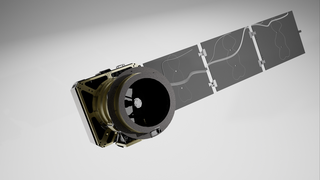NASA’s Pandora Mission Closer To Probing Alien Atmospheres
Watch to learn more about NASA's Pandora mission, which will revolutionize the study of exoplanet atmospheres.
Credit: NASA's Goddard Space Flight Center
Music: “Mesmeric Thoughts,” Andrew Michael Hewitt [PRS], Universal Production Music
Watch this video on the NASA Goddard YouTube channel.
Complete transcript available.
Pandora, NASA’s newest exoplanet mission, is one step closer to launch with the completion of the spacecraft bus, which provides the structure, power, and other systems that will enable the mission to carry out its work.
Pandora is a small satellite that will provide in-depth study of at least 20 known planets orbiting distant stars in order to determine the composition of their atmospheres — especially the presence of hazes, clouds, and water. This data will establish a firm foundation for interpreting measurements by NASA’s James Webb Space Telescope and future missions that will search for habitable worlds.
Astronomers view the presence of water as a critical aspect of habitability because water is essential to life as we know it. But variations in light from a planet's host star can mask or mimic the signal of water. Separating these sources is where Pandora will shine.
Funded by NASA’s Astrophysics Pioneers program for small, ambitious missions, Pandora is a joint effort between Lawrence Livermore National Laboratory in California and NASA Goddard.
Astronomers can sample an exoplanet’s atmosphere when it passes in front of its star as seen from our perspective, an event called a transit. Part of the star’s light skims the atmosphere before making its way to us. This allows the light to interact with atmospheric substances, and their chemical fingerprints — dips in brightness at characteristic wavelengths — become imprinted in the light.
But our telescopes see light from the entire star as well, not just what’s grazing the planet. Stellar surfaces aren’t uniform. They sport hotter, unusually bright regions called faculae and cooler, darker regions similar to sunspots, both of which grow, shrink, and change position as the star rotates.
Using a novel all-aluminum, 45-centimeter-wide (17 inches) telescope, jointly developed by Livermore and Corning Specialty Materials in Keene, New Hampshire, Pandora’s detectors will capture each star’s visible brightness and near-infrared spectrum at the same time, while also obtaining the transiting planet’s near-infrared spectrum. This combined data will enable the science team to determine the properties of stellar surfaces and cleanly separate star and planetary signals.
Over the course of its year-long prime mission, Pandora will observe at least 20 exoplanets 10 times, with each stare lasting a total of 24 hours. Each observation will include a transit, which is when the mission will capture the planet’s spectrum.
Watch to learn more about NASA's Pandora mission, which will revolutionize the study of exoplanet atmospheres. Vertical version of the video.
Credit: NASA's Goddard Space Flight Center
Music: “Mesmeric Thoughts,” Andrew Michael Hewitt [PRS], Universal Production Music
Complete transcript available.

Pandora’s spacecraft bus was photographed Jan. 10 within a thermal-vacuum testing chamber at Blue Canyon Technologies in Lafayette, Colorado. The bus provides the structure, power, and other systems that will enable the mission to help astronomers better separate stellar features from the spectra of transiting planets.
Credit: NASA/Weston Maughan, BCT
Image description: In this vertical photo, a metal box placed on a short stand with red supports rests within a large, dark cylindrical chamber. A bundle of blue wires extends from the upper left of the chamber into a coil at the bottom left of the stand. Blue, black, pink, and gold wires can be seen connecting to the front of the box. The background is an off-white wall, and a column is visible at right.

Pandora's solar panel reaches its full extent during a deployment test at Blue Canyon Technologies in Lafayette, Colorado.
Credit: NASA/BCT Solar Array Team
Image description: On a shiny metal table, a gray panel stands on its edge, extending from left foreground to right. The panel rests on two triangular metal supports with circular blue feet. A thin wire snakes across the tabletop. The panel is divided into three sections joined by hinges, and each section contains a total of 90 blue squares — solar cells — in two rectangular groups. In the background are blue-legged tables, chairs, and other equipment.

Pandora's spacecraft bus is seen during powered testing at Blue Canyon Technologies in Lafayette, Colorado.
Credit: NASA/Ward Handley, BCT
Image description: On top of a metal test stand with red supports rests a silvery box with several cutouts and two conical shapes oriented toward the camera. It has several cables attached. A rectangular element extends above the box with a thick, black cable draped over it. Other wires run along the top of the box and down along its right side. In the background, a table with blue legs holds two inactive flat panel displays, and a blue chair lies in front of them. On an off-white wall behind the table, a large American flag dominates the scene.

An artist's concept of the Pandora mission, seen here without the thermal blanketing that will protect the spacecraft, observing a star and its transiting exoplanet.
Credit: NASA's Goddard Space Flight Center/Conceptual Image Lab
Image description: Against a starry backdrop, a metallic spacecraft observes a mottled yellow and orange star with a planet silhouetted in front of it. The planet has a bluish rim, indicating an atmosphere. Extending from the spacecraft toward lower left is a rectangle containing panels of blue and purple that represents Pandora's solar array.
Credits
Please give credit for this item to:
NASA's Goddard Space Flight Center. However, individual items should be credited as indicated above.
-
Producer
- Scott Wiessinger (eMITS)
-
Science writer
- Francis Reddy (University of Maryland College Park)
-
Scientists
- Elisa Quintana (NASA/GSFC)
- Ben Hord (NASA/GSFC)
-
Animators
- Jonathan North (eMITS)
- Chris Smith (eMITS)
Release date
This page was originally published on Thursday, January 16, 2025.
This page was last updated on Monday, March 10, 2025 at 7:33 AM EDT.
